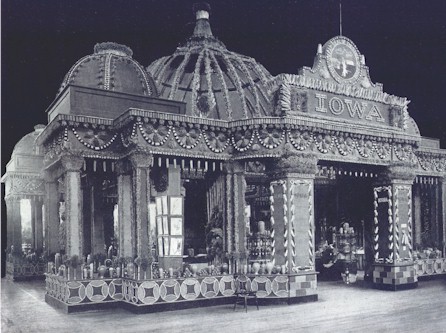
|
Agricultural History Series |
Missouri State University |
1904 St. Louis Worlds Fair
The Iowa Display
The Iowa exhibit featured a golden ear of corn with silver husks, silver cups, and other trophies. The golden ear was the prize for the best corn from an Iowa corn club. A corn club was made up of four neighboring farmers. Six ears of corn were picked from each club as an entry. The ears were judged at the farmers’ institute.

The Forest City Series of 1904 showed the above photo and gave the following description:
IOWA’S CORN TROPHIES.—A central location in the Palace of Agriculture is occupied by the grain pavilion of Iowa, the primary purpose being to show the world the kinds of grain produced on Iowa’s soil and beyond that to inform visiting farmers of proper methods of cultivation. One of the exhibits in this pavilion is an average corn stalk with its roots permitted to extend over a radius of fully two feet. This is to teach the farmer the growth of corn roots when allowed to extend naturally and to show him that deep cultivation at the wrong time cuts off roots and restricts the later growth of the corn. Hundreds of jars of seeds show the almost bewildering variety of grains grown to perfection in the State of Iowa. In the pavilion are three notable corn trophies. One is a loving cup with a design in corn. Another is a silver and gold ear of corn that forms a vase. The third is an ear of corn made of silver and gold. These three prizes were offered for the three best entries of ten ears of corn each produced in the State. Iowa’s agricultural exhibit carries the artistic idea into the display of dairy products. A bust of John Stewart, the father of the modern creamery, is shown, modeled in butter. Beside the bust is a miniature reproduction of Stewart’s old dairy house, built by him in 1872, with a companion piece in the model dairy school at Ames, a branch of the Iowa College of Agriculture.
Reference: The Agriculture Conquest of the Earth. Pp. 192
This page is designed by Andrea Starkey and is maintained by Lyndon Irwin.